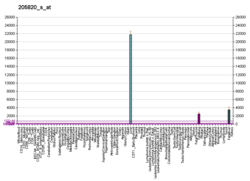Apolipoprotéine C-III
| APOC3 | |||||||||||||||||||||||||||||||||||||||||||||||||||
|---|---|---|---|---|---|---|---|---|---|---|---|---|---|---|---|---|---|---|---|---|---|---|---|---|---|---|---|---|---|---|---|---|---|---|---|---|---|---|---|---|---|---|---|---|---|---|---|---|---|---|---|
 | |||||||||||||||||||||||||||||||||||||||||||||||||||
| Visualisation de la protéine Cristallisée APOC3 | |||||||||||||||||||||||||||||||||||||||||||||||||||
| |||||||||||||||||||||||||||||||||||||||||||||||||||
| Identifiants | |||||||||||||||||||||||||||||||||||||||||||||||||||
| Aliases | APOC3, Apolipoprotéine C-III, apo C-III, apo-C3 | ||||||||||||||||||||||||||||||||||||||||||||||||||
| IDs externes | OMIM: 107720 MGI: 88055 HomoloGene: 81615 GeneCards: APOC3 | ||||||||||||||||||||||||||||||||||||||||||||||||||
| |||||||||||||||||||||||||||||||||||||||||||||||||||
| |||||||||||||||||||||||||||||||||||||||||||||||||||
| |||||||||||||||||||||||||||||||||||||||||||||||||||
| |||||||||||||||||||||||||||||||||||||||||||||||||||
| |||||||||||||||||||||||||||||||||||||||||||||||||||
| Wikidata | |||||||||||||||||||||||||||||||||||||||||||||||||||
| |||||||||||||||||||||||||||||||||||||||||||||||||||
L'apolipoprotéine C-III (ou apo C-III, ou apo-C3) est une lipoprotéine impliquée dans le métabolisme des triglycérides.
Structure
Cette apolipoprotéine est située à la surface des chylomicrons et sont l'un des constituants des VLDL et des HDL.
Elle est composée d'une chaîne peptidique de 79 acides aminés, couplée à une chaine glucidique, formant une structure en 6 hélices alpha[5]. Son expression est essentiellement intestinale et hépatique.
Génétique
Son gène est le APOC3 et est situé sur le chromosome 11 humain[5].
Une mutation d'un promoteur du gène provoque une hyperexpression de l'APOC3 résultant en une résistance à l'insuline[6].
D'autres mutations décrites concernent le gène lui-même, entraînant la synthèse d'une protéine moins active, avec baisse du taux des triglycérides, augmentation de celui des HDL et une probable protection contre l'athérome[7],[8],[9].
Rôles
Elle inhibe l’activité de le lipoprotéine lipase[10]. Elle serait l'un des mécanismes de l'hypertriglycéridémie, probablement par inhibition du catabolisme des triglycérides[11]. Elle participe également à la formation des VLDL dans les cellules hépatiques[12].
En médecine
Son taux est augmentée en cas d'hypertriglycéridémie, de surcharge pondérale et de résistance à l'insuline[13], probablement par un ralentissement de son catabolisme[14]. Sa concentration sanguine est corrélée avec le risque de maladies cardiovasculaires de manière plus spécifique que le taux de triglycérides[15] ou que d'autres apolipoprotéines[16].
Un oligonucléide antisens est en cours de développement, permettant l'inhibition du gène APOC3 et la baisse du taux de triglycérides chez l'humain et plusieurs modèles animaux[17]. Olezarsen (Ionis) un oligonucleotide antisens a été testé sur une petite cohorte de patient avec succès pendant 6 mois[18]
Notes et références
- ↑ a b et c GRCh38: Ensembl release 89: ENSG00000110245 - Ensembl, May 2017
- ↑ a b et c GRCm38: Ensembl release 89: ENSMUSG00000032081 - Ensembl, May 2017
- ↑ « Publications PubMed pour l'Homme », sur National Center for Biotechnology Information, U.S. National Library of Medicine
- ↑ « Publications PubMed pour la Souris », sur National Center for Biotechnology Information, U.S. National Library of Medicine
- ↑ a et b Huff MW, Hegele RA, Apolipoprotein C-III: Going back to the future for a lipid drug target, Circulation Research, 2013;112:1405-1408
- ↑ Li WW, Dammerman MM, Smith JD, Metzger S, Breslow JL, Leff T, Common genetic variation in the promoter of the human apo CIII gene abolishes regulation by insulin and may contribute to hypertriglyceridemia, J Clin Invest, 1995;96:2601–2605
- ↑ Pollin TI, Damcott CM, Shen H et al. A null mutation in human APOC3 confers a favorable plasma lipid profile and apparent cardioprotection, Science, 2008;322:1702–1705
- ↑ The TG and HDL Working Group of the Exome Sequencing Project, National Heart, Lung, and Blood Institute, Loss-of-function mutations in APOC3, triglycerides, and coronary disease, N Engl J Med, 2014;371:22-31
- ↑ Jørgensen AB, Frikke-Schmidt R, Nordestgaard BG, Tybjærg-Hansen A, Loss-of-function mutations in APOC3 and risk of ischemic vascular disease, N Engl J Med, 2014;371:32-41
- ↑ McConathy WJ, Gesquiere JC, Bass H, Tartar A, Fruchart JC, Wang CS, Inhibition of lipoprotein lipase activity by synthetic peptides of apolipoprotein C-III, J Lipid Res, 1992;33:995–1003
- ↑ Jong MC, Hofker MH, Havekes LM, Role of ApoCs in lipoprotein metabolism: functional differences between ApoC1, ApoC2, and ApoC3, Arterioscler Thromb Vasc Biol, 1999;19:472–484
- ↑ Qin W, Sundaram M, Wang Y et al. Missense mutation in APOC3 within the C-terminal lipid binding domain of human ApoC-III results in impaired assembly and secretion of triacylglycerol-rich very low density lipoproteins: evidence that ApoC-III plays a major role in the formation of lipid precursors within the microsomal lumen, J Biol Chem, 2011;286:27769–27780
- ↑ Cohn JS, Patterson BW, Uffelman KD, Davignon J, Steiner G, Rate of production of plasma and very-low-density lipoprotein (VLDL) apolipoprotein C-III is strongly related to the concentration and level of production of VLDL triglyceride in male subjects with different body weights and levels of insulin sensitivity, J Clin Endocrinol Metab, 2004;89:3949–3955
- ↑ Huff MW, Fidge NH, Nestel PJ, Billington T, Watson B, Metabolism of C-apolipoproteins: kinetics of C-II, C-III1 and C-III2, and VLDL-apolipoprotein B in normal and hyperlipoproteinemic subjects, J Lipid Res, 1981;22:1235–1246
- ↑ Sacks FM, Alaupovic P, Moye LA et al. VLDL, apolipoproteins B, CIII, and E, and risk of recurrent coronary events in the Cholesterol and Recurrent Events (CARE) trial, Circulation, 2000;102:1886–1892
- ↑ Pechlaner R, Tsimikas S, Yin X et al. Very-low-density lipoprotein-associated apolipoproteins predict cardiovascular events and are lowered by inhibition of APOC-III, J Am Coll Cardiol, 2017;69:789–800
- ↑ Graham MJ, Lee RG, Bell TA 3rd et al. Antisense oligonucleotide inhibition of apolipoprotein C-III reduces plasma triglycerides in rodents, nonhuman primates, and humans, Circ Res, 2013;112:1479–1490
- ↑ N Engl J Med 2024;390:1770-1780 DOI: 10.1056/NEJMoa2402309VOL. 390 NO. 19
 Portail de la médecine
Portail de la médecine  Portail de la biologie cellulaire et moléculaire
Portail de la biologie cellulaire et moléculaire


















